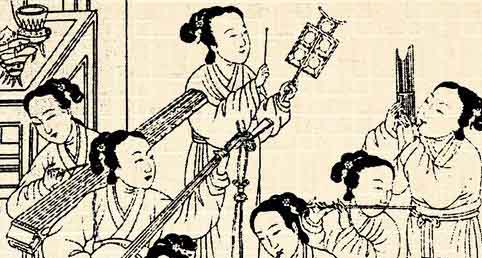

The music of China dates back to the dawn of Chinese civilization with documents and artifacts providing evidence of a well-developed musical culture as early as the Zhou Dynasty (1122 BC Ð 256 BC). Today, the music continues a rich traditional heritage in one aspect, while emerging into a more contemporary form at the same time.
The legendary founder of music in Chinese mythology was Ling Lun, who made bamboo pipes tuned to the sounds of birds.
According to Mencius, a powerful ruler once asked him whether it was moral if he preferred popular music to the classics. The answer was that it only mattered that the ruler love his subjects. The Imperial Music Bureau, first established in the Qin Dynasty (221-07 BC), was greatly expanded under the Emperor Han Wu Di (140-87 BC) and charged with supervising court music and military music and determining what folk music would be officially recognized. In subsequent dynasties, the development of Chinese music was strongly influenced by foreign music, especially Central Asia.
The oldest known written music is Youlan or the Solitary Orchid, attributed to Confucius (see guqin article for a sample of tablature). The first major well-documented flowering of Chinese music was for the qin during the Tang Dynasty, though the qin is known to have been played since before the Han Dynasty.
In ancient China the position of musicians was much lower than that of painters, though music was seen as central to the harmony and longevity of the state. Almost every emperor took folk songs seriously, sending officers to collect songs to inspect the popular will. One of the Confucianist Classics, Shi Jing (poets), contained many folk songs dating from 800 BC to about 300 BC.
The first European to reach China with a musical instrument was Jesuit priest Matteo Ricci who presented a Harpsichord to the Ming imperial court in 1601, and trained four eunuchs to play it.
The New Culture Movement of the 1910s and 1920s evoked a great deal of lasting interest in Western music. A number of Chinese musicians returned from studying abroad to perform Western classical music, composing work based on Western musical notation system. The Kuomintang tried to sponsor modern music adoptions via the Shanghai Conservatory of Music despite the ongoing political crisis. 20th-century cultural philosophers like Xiao Youmei, Cai Yuanpei, Feng Zikai and Wang Guangqi wanted to see Chinese music adopted to the best standard possible. There were many different opinions regarding the best standard.
Symphony orchestras were formed in most major cities and performed to a wide audience in the concert halls and on radio. Many of the performers added jazz influences to traditional music, adding xylophones, saxophones and violins, among other instruments. LŸ Wencheng, Li Jinhui, Zhou Xuan, Qui Hechou, Yin Zizhong and He Dasha were among the most popular performers and composers during this period.
After the 1942 Yan'an Forum on Literature and Art, a large-scale campaign was launched in the Communist controlled areas to adapt folk music to create revolutionary songs to educate the largely illiterate rural population on party goals. Musical forms considered superstitious or anti-revolutionary were repressed, and harmonies and bass lines were added to traditional songs. One example is The East Is Red, a folksong from northern Shaanxi which was adapted into a nationalist hymn. Of particular note is the composer, Xian Xinghai, who was active during this period, and composed the Yellow River Cantata which is the most well-known of all of his works. Read more
An ancient Chinese myth tells of the discovery of the "foundation tone," which, in addition to being a musical note of specific pitch, also had political implications, since each dynasty was thought to have its own "proper pitch." Tones are an indispensable part of Chinese literature, as characters in poetry and prose were chosen according to tones and rhymes for their euphony. This use of language helps in reconstructing the pronunciation of Old Chinese and Middle Chinese, since the Chinese writing system is logographic.
The foundation tone was produced when Ling Lun, the founder of Chinese music and a scholar, went to the western mountain area of China and cut a bamboo pipe in such a way that it produced the correct sound. He is said to have travelled to a distant land and made a set of 12 flutes with bamboo. This set of flutes could produce 12 tones and became the basis of music.

Some of 30 flutes unearthed
September 22, 1999 - Reuters - London
Archaeologists have found the world's oldest playable flute in China.The 9,000 year-old, 8.6 inch instrument in pristine condition has seven holes and was made from a hollow bone of a bird, the red-crowned crane. It is one of six flutes and 30 fragments recovered from the Jiahu archaeological site in Henan province.
A fragment of a 45,000 year-old flute was previously found in Slovenia but it could not be played. The researchers believe the site will turn out to be one of the most important Neolithic sites ever found. In addition to proving that the early Chinese were accomplished musicians and craftspeople the Jiahu site also reveals much about their culture.
During this period 9,000 years ago, the Chinese in this village Jiahu already had established a village life. They had parts of the city, or village that were devoted to different functions. Some of the other flutes, which have between five and eight holes, could also be played but produced a cracking sound that alarmed researchers who feared the instruments could be damaged. The scientists plan to make replicas of the ancient instruments to study their tonal qualities without endangering the instruments.